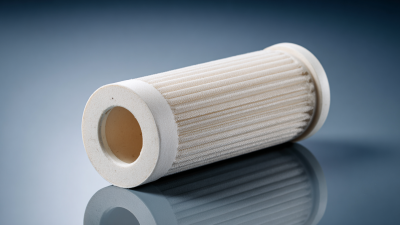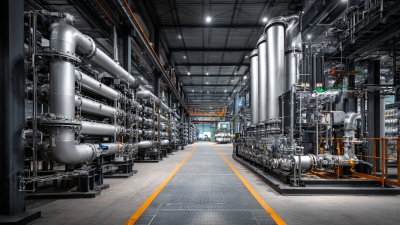Leave Your Message
Request a Quote
In today's rapidly evolving industrial landscape, the significance of efficient fluid transfer solutions cannot be overstated. Peristaltic pumps, renowned for their precision and reliability, have emerged as vital components in various sectors, including pharmaceuticals, food and beverage, and wastewater management. According to a recent market report, the global peristaltic pump market is projected to reach USD 1.03 billion by 2027, growing at a CAGR of 6.2% during the forecast period. This growth is attributed to the increasing demand for accurate and contamination-free fluid handling processes. Peristaltic pumps operate on a unique principle that ensures minimal shear stress on the fluid, making them ideal for sensitive applications. Understanding their role in modern fluid transfer solutions is essential for optimizing efficiency and ensuring the integrity of transferred substances across diverse industries.

Peristaltic pumps have undergone significant evolution since their inception, playing a crucial role in modern fluid transfer technologies. Originally designed for simple applications, these pumps have advanced to meet the demands of various industries, including pharmaceuticals, food and beverage, and wastewater management. Their ability to handle delicate fluids with precision has made them indispensable in processes that require sterility and minimal shear stress. Recent innovations include the incorporation of smart technology, allowing for real-time monitoring and greater efficiency.
**Tip:** When selecting a peristaltic pump, consider the specific requirements of your fluid transfer application, such as viscosity, flow rate, and the nature of the liquids being handled. This can save time and resources in the long run.
The integration of advanced materials in peristaltic pump construction has also contributed to their longevity and reliability. Modern designs utilize wear-resistant tubing and advanced elastomers to ensure consistent performance over time. The advent of digital controls and automated systems has further enhanced the versatility of these pumps, allowing for seamless integration into automated fluid transfer systems.
**Tip:** Regular maintenance and proper calibration of peristaltic pumps are essential to prevent operational issues. Establishing a routine check can help extend the lifespan of the equipment and maintain optimal performance.
| Parameter | Description | Application | Advantages |
|---|---|---|---|
| Flow Rate | The volume of fluid transferred per unit time. | Used in laboratories and various industries. | Precise dosing and consistent output. |
| Materials Compatibility | Ability to handle various chemicals and fluids. | Chemical processing, food and beverage production. | Reduced risk of contamination. |
| Operating Pressure | Maximum pressure at which the pump can operate. | Water treatment and pharmaceuticals. | Enhanced operational safety. |
| Viscosity Handling | The capability to pump fluids of various thicknesses. | Cosmetics and food industry. | Versatile performance across applications. |
| Maintenance Requirements | Frequency and complexity of necessary upkeep. | Industrial settings and home applications. | Lower total maintenance costs over time. |
Peristaltic pumps have emerged as essential tools in fluid transfer solutions, particularly due to their unique operational principles that offer several advantages over conventional pumping methods. The primary advantage lies in their gentle pumping mechanism, which minimizes shear stress on fluids. This characteristic makes peristaltic pumps ideal for handling sensitive materials, such as biological samples in biomedical applications. Recent developments, such as peristaltic electromagnetic micropumps featuring dome-shaped PDMS membranes, enhance this capability further by improving flow control and reducing contamination risks during fluid transfer.

Moreover, peristaltic pumps are versatile and can efficiently transfer various fluids, from viscous liquids to shear-sensitive materials. Their design allows for easy cleaning and maintenance, reducing downtime and improving operational efficiency. In applications like in vitro drug screening and cell therapy, the ability to precisely control fluid dynamics is critical. This highlights the role of peristaltic pumps not only in traditional industries but also in cutting-edge fields like microfluidics, where maintaining the integrity of samples is paramount. Overall, the advantages of peristaltic pumps make them an indispensable part of modern fluid transfer solutions across multiple sectors.
The peristaltic pump market is witnessing significant growth due to an increasing demand for precise and contamination-free fluid transfer, particularly in sectors like pharmaceuticals and food processing. According to industry reports, the peristaltic pumps market is projected to reach approximately USD 2.38 billion by 2030, driven by advancements in automation and the critical need for accurate flow control. This rise is further supported by the ongoing trend towards single-use systems, which enhances the appeal of peristaltic pumps in sterile environments.
Moreover, the global single-use pump market, which includes peristaltic pumps as a key segment, is expected to grow from USD 606.34 million in 2025 to a staggering USD 2,133.2 million by 2034, marking a robust compound annual growth rate. This growth reflects the broader industry shift towards automation and the increasing need for equipment that minimizes the risk of contamination. As these trends continue to evolve, peristaltic pumps are positioned as essential components in modern fluid transfer solutions, catering to both current and future industry needs.

When selecting peristaltic pumps for industrial applications, several critical considerations come into play. First and foremost, fluid characteristics such as viscosity, pH, and temperature must be evaluated, as these directly influence pump performance. According to a report by Research and Markets, the global peristaltic pump market was valued at approximately $1.2 billion in 2020, with a projected growth rate of 6.5% through 2025. This growth is largely attributed to the versatility of peristaltic pumps in handling various fluids, including aggressive chemicals and shear-sensitive formulations.
Another important factor is the pump design and material of construction, particularly for industries such as food and beverage, pharmaceuticals, and water treatment. For instance, the selection of hose material is vital to prevent contamination and ensure compatibility with the conveyed media. A study from Allied Market Research indicates that the rising demand for hygienic fluid transfer solutions is leading manufacturers to innovate with materials like silicone and thermoplastic elastomers, which provide enhanced durability and compliance with regulatory standards. By carefully considering these factors, businesses can optimize their fluid transfer processes, thereby improving efficiency and product integrity.
Peristaltic pumps have become integral to fluid transfer solutions across various industries due to their unique ability to handle diverse materials safely and efficiently. According to a recent report by MarketsandMarkets, the global peristaltic pump market is expected to reach $1.5 billion by 2025, driven by their reliability in sectors such as pharmaceuticals and food processing. In the pharmaceutical industry, these pumps are crucial for precision dosing and transferring viscous fluids, where contamination must be avoided. A case study from a leading biopharmaceutical manufacturer highlighted how peristaltic pumps significantly enhanced their production efficiency by reducing downtime related to pump maintenance.
In the food and beverage sector, peristaltic pumps demonstrate exceptional performance in transferring sensitive ingredients like sauces and purees, where shear sensitivity is a concern. An analysis by ResearchAndMarkets revealed that the food and beverage segment accounts for over 35% of the peristaltic pump market share. A notable example is a beverage company that integrated peristaltic pumps into their production line, resulting in a 20% increase in throughput while maintaining product integrity. These case studies emphasize the versatility and effectiveness of peristaltic pumps in optimizing fluid transfer operations across varying applications.







